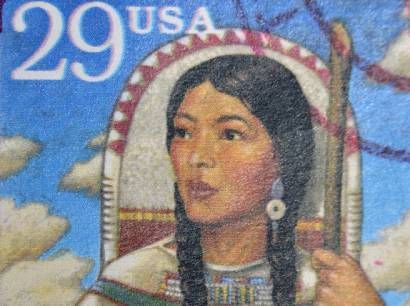This Week's Story
subscribe to podcast [click here] or play audio below
Fact and fiction swirl around Sacajawea, including surprises.

This Week’s Story relives American history and the Bible through brief inspiring stories presented on mp3 audio recordings and text for reading.
Surprises with Sacajawea,
part one
I was astonished to read the words, “More memorials honor Sacajawea than any other American woman. Monuments, markers, parks, lakes, and mountain peaks have been named for her.” Her face was chosen to be on the 2000 American dollar coin. I’ve wondered, “Why has she received so much attention?”
I was taught, as most American school children, that Sacajawea was a Native-American woman, who helped Captain Lewis and Captain Clark on their famous pioneer expedition. A team of people was to travel through unknown and dangerous territories to find and map a water and land route from St. Louis, Missouri to the Pacific Ocean.
Not much is known about Sacajawea. Fact and fiction swirl around her, including surprises. I’ve begun to discover why she captures imaginations. On that important exploration she was the only female, a teenage girl, about sixteen, with at least thirty men!! She was the only Native-American! Sacajawea is the stuff of legends. Perhaps she is in a league with St. Patrick, Joan of Arc, and King Arthur. Certainly, like them, she is not all legend.
Sacajawea entered hand-written historical records for about a year and a half, beginning November 11, 1804. Scattered comments were made about her in journals kept by members of the expedition. She also is in Native-American oral history.
When Sacajawea was allowed to join the group as an unofficial member, she was six months pregnant and the property of a forty-six year-old French-Canadian, Toussaint Charbonneau. She was considered his squaw or wife. They had no official marriage paperwork. Some historians speculate that Charbonneau got Sacajawea in a gambling game or for barter.
He wasn’t much of a man. Indians called him names of ridicule. He took many Indian wives throughout his adult years and even into his eighties. Often he was mean and petty. Lewis and Clark defended Sacajawea against Charbonneau’s attempts to beat her. He was clumsy around horses and in boats. Yet, he was hired to be an interpreter for the Lewis and Clark Expedition. Charbonneau could not speak any Indian languages well. However, he was an effective communicator through the use of sign language.
Sacajawea had been kidnapped from her tribe. After Charbonneau acquired her, she ended up in North Dakota, many miles from her home in Idaho. She was small and mild-mannered. But, she was of potential value to the mission! Her people, the Shoshones, had horses and the explorers would be travelling through her childhood homeland. She could help as a guide and an interpreter.
Captain Lewis and Captain Clark hoped Sacajawea’s baby would be born before the trip continued. The baby met the deadline. Captain Lewis recorded, “I was not prepared for childbirth on the trip.” The journals of four members record that Sacajawea’s labor was long and hard.
One trip member, Jussome, suggested, “I’ve heard that the powdered rattle of a rattlesnake can help labor.”
Captain Lewis answered, “We can try it. I have a snake rattle. Take these two rings of it.”
Jussome broke the snake rattle into small pieces and mixed it with water. Ten minutes later Sacajawea gave birth to a baby boy. Pomp was his nickname. For the remainder of the trip’s travel he was carried on his mother’s back. It was a trip we will explore soon.
This is Barbara Steiner. I invite you to check out www.thisweeksstory.com.
<< previous story] [next story >>
We invite your comments! [click here to comment]
This Week's Story is a non-profit supported by listeners. [click here to make a donation]
